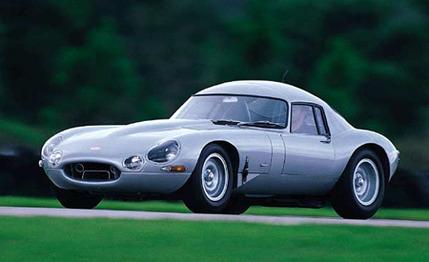 Specialty File
Specialty File

For the fine-threaded car nut, the thought of driving a thoroughbred racing car on the street is a recurring fantasy. Unfortunately, modern race cars are such dedicated implements of velocity that they are totally impractical and uncomfortable for street use. However, older race cars, especially those racing sports cars designed for long-distance runs, are less highly strung. For example, the dozen or so racing E-type Jaguars created in the '60s to run for the 24 hours at Le Mans and in other endurance races would make fine street machines, except for the fact that they are highly collectible classics. A lightweight racing E-type in need of a complete and very expensive restoration recently sold at auction for $872,050.
Enter Vicarage, a tiny firm owned by an American, Tony Parkinson, that produces about half a dozen specialized Jaguars every year in Atherstone, England. Vicarage, so named because the founders started the firm in a vicar's garage, has recently built a replica of the 1963 Lindner-Nocker coupe, a one-off racing E-type eponymously named after Peter Lindner and Peter Nocker, the pair of Germans who campaigned it.

The original Lindner-Nocker coupe began life as an E-type. To improve its drag coefficient and reduce its frontal area, it was given a new body. Malcolm Sayer, the designer of the E-type, provided extensive input in the building of this low-drag variant. The result is positively stunning, yielding a shape that is far more muscular yet every bit as graceful as the original.
With its lowered and narrowed cab, more steeply sloped windshield, tapered tail, teardroplike nose, and wide rear haunches, the Vicarage coupe is a faithful re-creation of the original and catches the eyes of most noncomatose residents in south Florida, where Parkinson's offices are located. Vicarage crafted the entire body, including the monocoque tub, from aluminum, to match the original.
Details are beautifully executed: the flip-up fuel-filler cap, the bent-wire trunklid latch, and the faired-in driving lights. Peer into the gaping front air intake, and you'll see various sheetmetal ducts channeling cooling air to the radiator, carburetors, and front brakes. As with the original car, the various body panels are held together by strings of rivets that are draped across the bodywork in curving lines like so many ribbons.
In keeping with its race-car origins, the car's interior is sparsely finished. Glance overhead, or behind, or down at the wide central tunnel, and all you'll see is raw sheetmetal. Still, there are door panels, a dashboard, and carpeting under your feet. You'll also find a Pioneer radio and CD changer as well as a '60s-era underdash air conditioner.
Mechanically, Vicarage has taken an E-type foundation and fortified it, using a mix of period and modern components. The Jaguar XK six-cylinder engine, taken from a donor E-type that also provided most of the mechanical components, has been overbored to a 4580cc displacement, fitted with a freer-flowing cylinder head with oversize valves, a trio of Weber carburetors, and sufficient internal engine mods to keep things together. Parkinson says it makes 300 horsepower, which is fed to an American-made JT5 five-speed transmission twisting a Quaiffe limited-slip differential.
The chassis has received a similar toning with vented front brake rotors gripped by four-piston AP calipers, Koni adjustable-ride-height shock absorbers, stiffer front torsion bars, softer rear springs, and longer steering arms to minimize bump steer with the lowered ride height. Replica Dunlop cast-aluminum peg-drive wheels (7.0 inches wide in front, 7.5 in the rear) wear Dunlop racing tires -- 5.50M-15s in front and 6.00M-15s in the rear. Overall weight is 2490 pounds, about 350 pounds lighter than a production E-type, despite bearing the weight of the air-conditioning system.
Its race-replica character notwithstanding, the Vicarage is a comfortable ride. The driving position is fine, with decent room for a six-footer. Rear visibility isn't great, and there are no outside mirrors, but wind noise, although hardly Lexus-hushed, is not bad at highway speeds. And neither is the exhaust rumble, as long as your foot is not planted on the floor.
When you do open the triple Webers, the Vicarage Low Drag Coupe scoots to 60 mph in 5.6 seconds and covers the quarter-mile in 14.1 seconds at 102 mph. Both figures are well over a second quicker than a stock Series I E-type can muster, although they're not as rapid as we would expect from a car with the same power, more torque, and about 600 pounds less weight than a Porsche 911. We didn't have an opportunity to measure its top speed, but we suspect the car can certainly approach 160 mph.
The stopping distance we measured -- 198 feet from 70 mph -- was about the same as a stock E-type's, but the 0.82-g skidpad figure reflects the improvement we expected from the racing tires.
More impressive than the raw performance is the car's balanced and robust nature. We ran numerous hard laps at Florida's Moroso Motorsports Park, and the Vicarage displayed predictable handling, minimal body roll, and excellent control. Charge a corner too hard, and the tail will get loose quickly, but the car doesn't rotate far and the slide is easily corrected. And despite the 95-degree weather, the car never hinted of overheating, even with the air conditioning running. Unfortunately, without a functioning drain in the system, all the moisture wrung from the air by the evaporator dribbled onto our legs in every right turn.
Still, the Vicarage Low Drag Coupe is an incredibly charismatic ride that functions on real-world roads while convincing its driver that he is about to pass Bob Bondurant's Cobra at the Mulsanne kink. Vicarage charges $135,000 for this hand-built time machine, and it's worth every penny.
Vicarage USA, 5333 Collins Avenue, No. 502, Miami Beach, Florida 33140; 305- 866-9511; www.vicarage-jaguar.com.